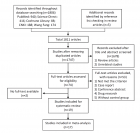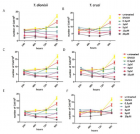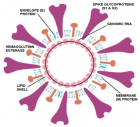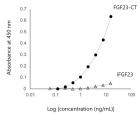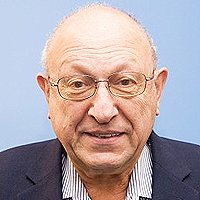Figure 1
Convalescent plasma therapy in aHUS patient with SARS-CoV-2 infection
Emma Diletta Stea*, Virginia Pronzo, Francesco Pesce, Marco Fiorentino, Adele Mitrotti, Vincenzo Di Leo, Cosma Cortese, Annalisa Casanova, Sebastiano Nestola, Flavia Capaccio and Loreto Gesualdo
Published: 22 April, 2022 | Volume 6 - Issue 1 | Pages: 036-039

Figure 1:
A) Trend of inflammatory markers: CRP line blue; IL-6-line gray. The red arrows indicate the hyper-immune plasma administration (between 7th to 9th of November). The patient presents two distinct infection peaks. During the first peak bacterial super-infection was not detected and the X-ray confirmed a COVID-19 pneumonia. CRP and IL-6 showed a significant decrease after the plasma infusion until the 28/29th of November when the patient developed a bacterial infection of the central venous catheter. B) Trend of PO2-FiO2 ratio. The patient developed a severe and fast decrease of P/F ratio requiring a ventilatory support since the 4th of November (CPA PEEP 8 cmH20 FiO2 80% - 100%). Hyper-immune plasma was administrated between 7th to 9th of November. There was an improvement of PO2/FiO2 ratio: from 84, at the beginning of the therapy, to 224 on the 3rd day of plasma administration without other ventilation change. The PO2-FiO2 ratio showed a slightly decrease between the 10th - 20th of November corresponding to a gradually ventilator weaning and recovery of the spontaneous breathing. On the top of the pictures, the two lines represent the concomitant medications. Pink line: i.v. dexamethasone (6 mg once daily for 16 days followed by a fast tapering) which had been administered since the admission. Blue line: i.v. Ceftriaxone that was added when clinical symptoms worsened. The “x” represents the time of first negative nasopharyngeal swab for SARS-CoV-2.
Read Full Article HTML DOI: 10.29328/journal.jcn.1001088 Cite this Article Read Full Article PDF
More Images
Similar Articles
-
Profile of vitamin D receptor polymorphism Bsm I and FokI in end stage renal disease Egyptian patients on maintenance hemodialysisEL-Attar HA*,Mokhtar MM,Gaber EW. Profile of vitamin D receptor polymorphism Bsm I and FokI in end stage renal disease Egyptian patients on maintenance hemodialysis. . 2017 doi: 10.29328/journal.jcn.1001005; 1: 026-040
-
Posterior Reversible Leukoencephalopathy Syndrome in a patient after second dose of Rituximab for treatment of resistant Thrombotic Thrombocytopenic PurpuraSabaa Asif*,Sumbal Nasir Mahmood,Osama Kunwer Naveed. Posterior Reversible Leukoencephalopathy Syndrome in a patient after second dose of Rituximab for treatment of resistant Thrombotic Thrombocytopenic Purpura . . 2018 doi: 10.29328/journal.jcn.1001010; 2: 001-004
-
Complete recovery of chronic Osmotic Demyelination Syndrome with plasma exchangeSumbal Nasir Mahmood*,Kunwer Naveed Mukhtar,Osama Kunwer Naveed,Ahmed Kunwer Naveed. Complete recovery of chronic Osmotic Demyelination Syndrome with plasma exchange. . 2018 doi: 10.29328/journal.jcn.1001011; 2: 005-007
-
Hypocomplementemic interstitial nephritis with long-term follow-upAlyssa Penning, M.D,Claire Kassakian, M.D,Donald C Houghton, M.D,Nicole K Andeen, M.D*. Hypocomplementemic interstitial nephritis with long-term follow-up. . 2019 doi: 10.29328/journal.jcn.1001024; 3: 042-045
-
Cytomegalovirus infection in native kidney biopsyRaquel M Moreira,Géssica SB Barbosa*,Cristiane B Dias,Luis Yu,Viktoria Woronik,Lívia B Cavalcante. Cytomegalovirus infection in native kidney biopsy. . 2019 doi: 10.29328/journal.jcn.1001047; 3: 186-186
-
Granulomatosis with polyangiitis (GPA) in a 76-year old woman presenting with pulmonary nodule and accelerating acute kidney injuryNoor Sameh Darwich*,Melissa Schnell,L. Nicholas Cossey. Granulomatosis with polyangiitis (GPA) in a 76-year old woman presenting with pulmonary nodule and accelerating acute kidney injury. . 2020 doi: 10.29328/journal.jcn.1001048; 4: 001-006
-
Hyperacute fatal course in a hypercalcemic crisisSara Turco*,Alice Chiara Manetti,Aniello Maiese,Matteo Scopetti,Marco Di Paolo. Hyperacute fatal course in a hypercalcemic crisis. . 2021 doi: 10.29328/journal.jcn.1001066; 5: 008-009
-
Prostate cancer-associated thrombotic microangiopathy: A case report and review of the literatureHHS Kharagjitsing*,PAW te Boekhorst,Nazik Durdu-Rayman. Prostate cancer-associated thrombotic microangiopathy: A case report and review of the literature. . 2021 doi: 10.29328/journal.jcn.1001068; 5: 017-022
-
Multifrecuency bioimpedance phase angle as a tool to predict maturation failure of native fistulae for hemodialysisJosé Lucas Daza Lopez*,John F Galindo,Mónica R Villaquiran,Emilio D Valenzuela,Andres Cardenas,Luis Jose Daza,Maria Camila Correcha,Jonathan de Jong,Yaroslad De La Cruz Prieto,Gerardo Gutierrez,Luis Puello. Multifrecuency bioimpedance phase angle as a tool to predict maturation failure of native fistulae for hemodialysis. . 2021 doi: 10.29328/journal.jcn.1001076; 5: 061-066
-
Convalescent plasma therapy in aHUS patient with SARS-CoV-2 infectionEmma Diletta Stea*,Virginia Pronzo,Francesco Pesce,Marco Fiorentino,Adele Mitrotti,Vincenzo Di Leo,Cosma Cortese,Annalisa Casanova,Sebastiano Nestola,Flavia Capaccio,Loreto Gesualdo. Convalescent plasma therapy in aHUS patient with SARS-CoV-2 infection. . 2022 doi: 10.29328/journal.jcn.1001088; 6: 036-039
Recently Viewed
-
Autoimmune encephalitis associated with an ovarian teratoma in a 29-year old womanA Plaikner*,A Jacob,J Rother,C Kohler. Autoimmune encephalitis associated with an ovarian teratoma in a 29-year old woman . Clin J Obstet Gynecol. 2019: doi: 10.29328/journal.cjog.1001018; 2: 013-016
-
Hygiene and Care Protocols for Implant-supported Dental Prostheses in Patients with DiabetesHakob Khachatryan, Emma Boshnaghyan, Sevak Papoyan, Gagik Hakobyan*. Hygiene and Care Protocols for Implant-supported Dental Prostheses in Patients with Diabetes. J Oral Health Craniofac Sci. 2024: doi: 10.29328/journal.johcs.1001047; 9: 009-014
-
Management of Non-contact Injuries, Nonspecific Chronic Pain, and Prevention via Sensory Conflicts Detection: Vertical Heterophoria as a Landmark IndicatorEric Matheron*. Management of Non-contact Injuries, Nonspecific Chronic Pain, and Prevention via Sensory Conflicts Detection: Vertical Heterophoria as a Landmark Indicator. J Nov Physiother Rehabil. 2024: doi: 10.29328/journal.jnpr.1001057; 8: 005-013
-
COVID-19 Pneumonia in Pregnancy: A Retrospective Study on Maternal and Neonatal OutcomesBenlghazi Abdelhamid*, Belouad Moad, Hanane Dabdi, Bouhtouri Yassine, Messaoudi Hamza1, Benali Saad, Ait Bouhou Rachid, El Mangoub Fatima, Elhassani Mly El Mehdi, Kouach Jaouad. COVID-19 Pneumonia in Pregnancy: A Retrospective Study on Maternal and Neonatal Outcomes. Clin J Obstet Gynecol. 2024: doi: 10.29328/journal.cjog.1001163; 7: 051-055
-
Dairy cattle producers’ perception on Oestrus Synchronization and mass artificial insemination services in Waliso and Ilu Districts of South West Shoa Zone of Oromia, EthiopiaAbera Fekata*,Ulfina Galmessa,Lemma Fita,Chala Merera,Amanuel Bekuma. Dairy cattle producers’ perception on Oestrus Synchronization and mass artificial insemination services in Waliso and Ilu Districts of South West Shoa Zone of Oromia, Ethiopia. Insights Vet Sci. 2020: doi: 10.29328/journal.ivs.1001020; 4: 010-013
Most Viewed
-
Evaluation of Biostimulants Based on Recovered Protein Hydrolysates from Animal By-products as Plant Growth EnhancersH Pérez-Aguilar*, M Lacruz-Asaro, F Arán-Ais. Evaluation of Biostimulants Based on Recovered Protein Hydrolysates from Animal By-products as Plant Growth Enhancers. J Plant Sci Phytopathol. 2023 doi: 10.29328/journal.jpsp.1001104; 7: 042-047
-
Feasibility study of magnetic sensing for detecting single-neuron action potentialsDenis Tonini,Kai Wu,Renata Saha,Jian-Ping Wang*. Feasibility study of magnetic sensing for detecting single-neuron action potentials. Ann Biomed Sci Eng. 2022 doi: 10.29328/journal.abse.1001018; 6: 019-029
-
Physical activity can change the physiological and psychological circumstances during COVID-19 pandemic: A narrative reviewKhashayar Maroufi*. Physical activity can change the physiological and psychological circumstances during COVID-19 pandemic: A narrative review. J Sports Med Ther. 2021 doi: 10.29328/journal.jsmt.1001051; 6: 001-007
-
Pediatric Dysgerminoma: Unveiling a Rare Ovarian TumorFaten Limaiem*, Khalil Saffar, Ahmed Halouani. Pediatric Dysgerminoma: Unveiling a Rare Ovarian Tumor. Arch Case Rep. 2024 doi: 10.29328/journal.acr.1001087; 8: 010-013
-
Prospective Coronavirus Liver Effects: Available KnowledgeAvishek Mandal*. Prospective Coronavirus Liver Effects: Available Knowledge. Ann Clin Gastroenterol Hepatol. 2023 doi: 10.29328/journal.acgh.1001039; 7: 001-010

HSPI: We're glad you're here. Please click "create a new Query" if you are a new visitor to our website and need further information from us.
If you are already a member of our network and need to keep track of any developments regarding a question you have already submitted, click "take me to my Query."






